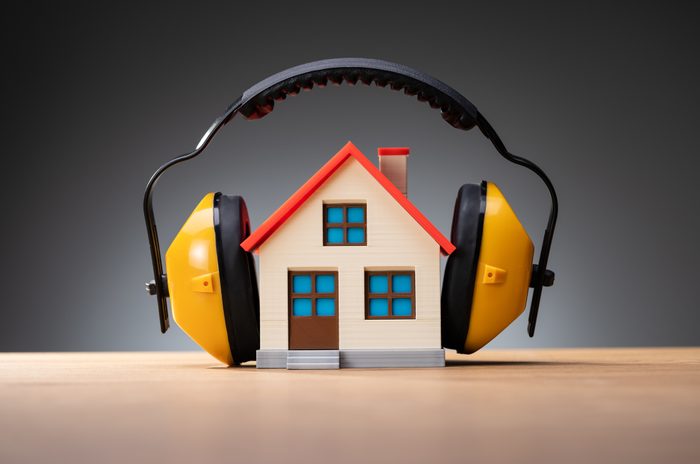Is It Possible To Soundproof an Entire House?

Soundproofing individual rooms is one thing. But can you can keep noisy nuisances out of a whole house?
Our editors and experts handpick every product we feature. We may earn a commission from your purchases.
In space, no one can hear you scream— because there’s no air. But down here inside the Earth’s atmosphere, there’s plenty of air. And as long as there’s air in your home, it’s probably impossible to completely exclude noise.
It is possible, though, to significantly reduce the noise entering your home, although it could be an expensive project.
I used to work in a recording studio. During construction, workers packed the walls with dense material and uncoupled the drywall with resilient channel. As a final touch, they lined the walls with acoustic panels to prevent reverberation. It all cost several thousand dollars. Sure, it was quiet. But even with the door closed, we could still hear a vacuum in the next room.
A whole house is harder to soundproof than a single room. The quality of the doors, windows and siding material, any gaps in the walls and ceiling, and the ambient outdoor noise levels all enter into the equation. In some cases, it might make more sense to soundproof individual rooms instead of the entire house, so people can at least get a good night’s sleep.
On This Page
How Does Sound Enter a House?
Sound travels from a source to our ears as a series of vibrations in the surrounding air. These pass freely through gaps between the doors and windows and the walls of a house. They also pass through solid materials by making them vibrate. Once inside the house, the vibrations reflect off hard, flat surfaces like walls, floors and ceilings.
“Amplitude” and “frequency” are the two characteristics of sound waves that most affect their transmission through materials like siding and drywall.
Amplitude is basically a measure of intensity. The greater it is, the louder the noise — and the more it can be heard indoors.
Frequency measures the number of vibrations per second. The higher the frequency, the higher the pitch. Building materials tend to vibrate in resonance with high-amplitude, low-pitch sounds like the bass from your neighbor’s boom box. They tend to pass more readily through the walls than low-amplitude, high-pitch sounds like birds chirping or people talking.
The noisiest areas of your home tend to be:
- Close to gaps: Mostly around doors and windows. Single-pane windows and hollow-core doors also effectively transmit sound.
- Near thin walls: Walls with thin siding, like vinyl or aluminum, tend to be noisier than those with heavier siding. This is true even if the walls are well-insulated because insulation doesn’t absorb much sound.
- Around ducts and vent pipes that extend through the wall or ceiling: Sound travels inside ducts and pipes. It can also be transmitted along the walls.
Does Soundproofing Work?
Yes. But it won’t make your house 100 percent quiet, and you wouldn’t want that anyway. The world’s quietest room is an anechoic chamber at Orfield Laboratories in Minnesota, and the longest anyone managed to stay inside it is 45 minutes.
There are three basic soundproofing strategies. You can use them individually or in combination.
- Increase mass: Dense materials don’t vibrate as readily as lightweight ones. You can increase the wall density with an extra layer of drywall or mass-loaded vinyl under the drywall.
- Dampen vibrations: If you can stop walls from vibrating, sounds won’t pass through them as easily. Common methods include decoupling the interior drywall from the studs with resilient channel or flexible acoustical caulk. If you’re building your home, you can also decouple the outside wall from the inside one by increasing the width by an inch or so and installing sets of alternating studs that don’t touch both walls.
- Absorb vibrations: Lining the walls with fabric or acoustic panels prevents sound from bouncing back and forth inside the room. Upholstered furniture also absorbs sound and can be strategically placed to make a room quieter.
Home Soundproofing
Soundproofing an existing room is a little more challenging than soundproofing during construction, but you can get great results if you don’t mind removing some existing drywall.
Once the wall studs are exposed, hang a layer of mass-loaded vinyl. Then install resilient channel or apply acoustic caulk along the stud faces to decouple the drywall. You can also install beefy, sound-absorbing mineral wool insulation, which will also keep your house warmer.
If removing the existing drywall isn’t in the cards, you can also add mass by installing an extra layer of drywall over the old one.
Before hanging the new drywall, coat the back with beads of acoustic caulk spaced about six inches apart to decouple the layers. If your budget allows, replace all single-pane windows with double-pane ones and all hollow-core doors with solid-core ones. Seal the inside and outside trim around doors and windows with caulk.
Non-invasive soundproofing solutions for renters include hanging acoustic panels on the walls, putting heavy carpets on the floors and hanging heavy drapes in the windows. Get your landlord to cover gaps in old doors — usually a significant source of noise — with weatherstripping or easy-to-install soundproofing seals.



